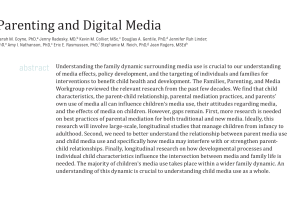Abstract
Understanding the family dynamic surrounding media use is crucial to our understanding of media effects, policy development, and the targeting of individuals and families for interventions to benefit child health and development. The Families, Parenting, and Media Workgroup reviewed the relevant research from the past few decades. We find that child characteristics, the parent-child relationship, parental mediation practices, and parents’ own use of media all can influence children’s media use, their attitudes regarding media, and the effects of media on children. However, gaps remain. First, more research is needed on best practices of parental mediation for both traditional and new media. Ideally, this research will involve large-scale, longitudinal studies that manage children from infancy to adulthood. Second, we need to better understand the relationship between parent media use and child media use and specifically how media may interfere with or strengthen parent child relationships. Finally, longitudinal research on how developmental processes and individual child characteristics influence the intersection between media and family life is needed. The majority of children’s media use takes place within a wider family dynamic. An understanding of this dynamic is crucial to understanding child media use as a whole.
This article was published in a special 2017 supplement of Pediatrics, a journal of the American Academy of Pediatrics. The supplement, “Children, Adolescents and Screens: What We Know and What We Need To Learn,” was produced by Children and Screens and includes the contributions of more than 130 interdisciplinary authors across 22 papers. See a complete list of articles included in the supplement.
